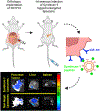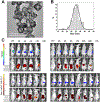Theranostic nanoparticles for detection and treatment of pancreatic cancer
- PMID: 39140128
- PMCID: PMC11328968
- DOI: 10.1002/wnan.1983
Theranostic nanoparticles for detection and treatment of pancreatic cancer
Abstract
Pancreatic ductal adenocarcinoma (PDAC) is one of the most recalcitrant cancers due to its late diagnosis, poor therapeutic response, and highly heterogeneous microenvironment. Nanotechnology has the potential to overcome some of the challenges to improve diagnostics and tumor-specific drug delivery but they have not been plausibly viable in clinical settings. The review focuses on active targeting strategies to enhance pancreatic tumor-specific uptake for nanoparticles. Additionally, this review highlights using actively targeted liposomes, micelles, gold nanoparticles, silica nanoparticles, and iron oxide nanoparticles to improve pancreatic tumor targeting. Active targeting of nanoparticles toward either differentially expressed receptors or PDAC tumor microenvironment (TME) using peptides, antibodies, small molecules, polysaccharides, and hormones has been presented. We focus on microenvironment-based hallmarks of PDAC and the potential for actively targeted nanoparticles to overcome the challenges presented in PDAC. It describes the use of nanoparticles as contrast agents for improved diagnosis and the delivery of chemotherapeutic agents that target various aspects within the TME of PDAC. Additionally, we review emerging nano-contrast agents detected using imaging-based technologies and the role of nanoparticles in energy-based treatments of PDAC. This article is categorized under: Implantable Materials and Surgical Technologies > Nanoscale Tools and Techniques in Surgery Therapeutic Approaches and Drug Discovery > Nanomedicine for Oncologic Disease Diagnostic Tools > In Vivo Nanodiagnostics and Imaging.
Keywords: active targeting; drug delivery; imaging; nanoparticle; pancreatic cancer.
© 2024 Wiley Periodicals LLC.
Conflict of interest statement
Conflict of Interest
The authors declare no conflicts of interest.
Figures






References
-
- Abdolahinia ED, Nadri S, Rahbarghazi R, Barar J, Aghanejad A, & Omidi Y (2019). Enhanced penetration and cytotoxicity of metformin and collagenase conjugated gold nanoparticles in breast cancer spheroids. Life sciences, 231, 116545. - PubMed
-
- Ahmed H, Gomte SS, Prathyusha E, Prabakaran A, Agrawal M, & Alexander A (2022). Biomedical applications of mesoporous silica nanoparticles as a drug delivery carrier. Journal of Drug Delivery Science and Technology, 76, 103729.
-
- Ait-Oudhia S, Straubinger RM, & Mager DE (2012). Meta-analysis of nanoparticulate paclitaxel delivery system pharmacokinetics and model prediction of associated neutropenia. Pharmaceutical research, 29, 2833–2844. - PubMed
-
- Alakhov V, Klinski E, Li S, Pietrzynski G, Venne A, Batrakova E, Bronitch T, & Kabanov A (1999). Block copolymer-based formulation of doxorubicin. From cell screen to clinical trials. Colloids and surfaces B: Biointerfaces, 16(1–4), 113–134.
Publication types
MeSH terms
Grants and funding
LinkOut - more resources
Full Text Sources
Medical

